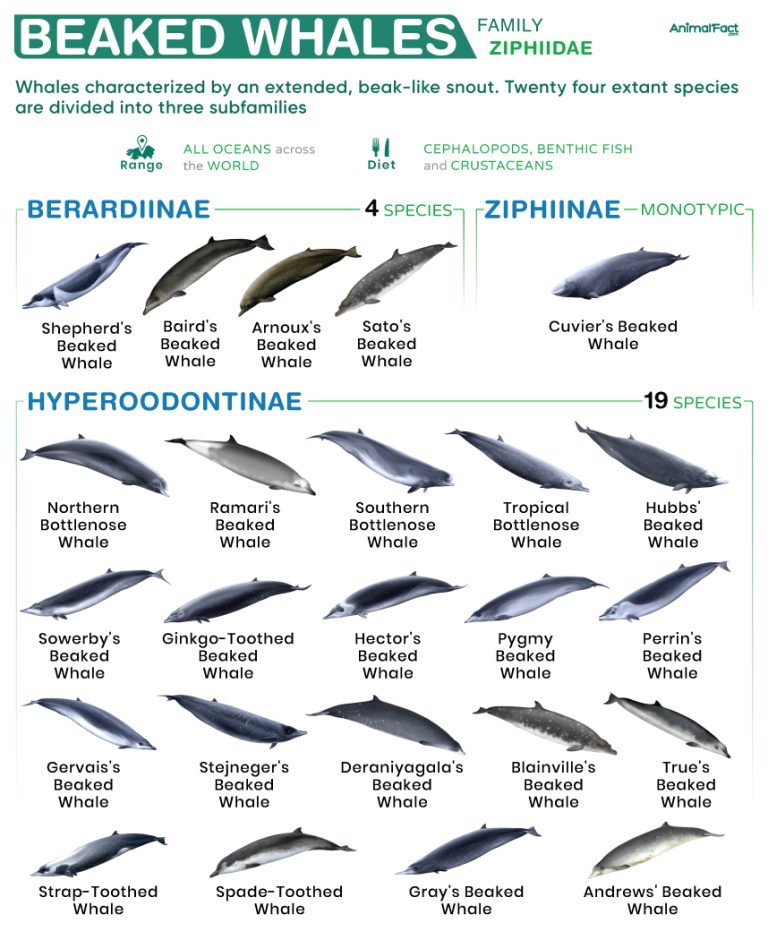


Beaked whales represent a group of deep-diving cetaceans that comprise the family Ziphiidae within Odontoceti, a parvorder constituting all toothed whales. They are distinguished by their extended, beak-like snouts, resembling dolphins. Most species have one or two pairs of tusk-like teeth that are found only in the males.

These marine mammals inhabit oceans across the globe, mostly preferring deep offshore waters. Well-adapted for extreme diving, they have collapsible lungs and a high capacity for storing oxygen, which allows them to reach depths of more than 2,000 m. Their diet mainly consists of cephalopods, such as squid, along with crustaceans and fish.
As of 2024, 24 species of beaked whales have been recognized. They are among the least studied mammals, primarily because their deep-sea habitat makes them difficult to access in the wild.
They are medium-sized mammals, typically measuring between 4 and 13 m (13 and 43 ft) in length and weighing between 1 and 15 tonnes. The largest species, Baird’s beaked whale, reaches about 11.9 m (39 ft) for males and 12.8 m (42 ft) for females. In contrast, the smallest species, the pygmy beaked whale, grows to around 4 m (13 ft).
These whales exhibit sexual dimorphism, with females being slightly larger than males in most species.
They have a streamlined, spindle-shaped body characterized by an extended snout or beak. In most species, the beak measures about 5 to 10% of the total body length. Their forelimbs are modified into small, rounded flippers, while a triangular dorsal fin is located about two-thirds down their back. They have small pectoral fins that tuck into pigmented pectoral pockets located along the sides of their bodies.
A distinctive feature of these whales is a pair of V-shaped grooves beneath the throat. Males are particularly notable for their large, bulging foreheads.
Beaked whales typically range between gray and black in color and have a thick layer of insulating blubber beneath their skin. Unlike in most whales, this layer is primarily composed of wax esters rather than the usual triacylglycerols.
Most beaked whales possess only one pair of tusk-like teeth exclusive to males, whereas females of most species have extremely tiny teeth that do not fully emerge from the gums. The females typically select mates based on the shape of the tusks, which therefore play a key role as a secondary sexual feature.
However, one species, the Shepherd’s beaked whale, is unique among beaked whales, as both sexes have a complete set of functional teeth (between 17 to 27 pairs in both jaws). However, males are distinguished by the presence of prominent tusks, whereas in females, the teeth remain extremely small and do not fully emerge.
In terms of species count, Ziphiidae represents the second-largest family of cetaceans after oceanic dolphins (family Delphinidae).
According to the Society for Marine Mammalogy, the 24 extant species of beaked whales are divided into 3 subfamilies and 6 extant genera.
Beaked whales are found worldwide across all the oceans. Though some species, like the northern bottlenose whale and the Sowerby’s beaked whale, are restricted to the North Atlantic waters, others, such as Blainville’s beaked whale and Cuvier’s beaked whale, have a more global distribution.
Although these whales prefer living in offshore waters (at least 300 m deep), they are also (though infrequently) found on icy edges at the poles. Additionally, they inhabit seamounts, canyons, escarpments, and oceanic islands such as the Azores and the Canary Islands. They can also be found in the waters surrounding Hawaii.
Though the primary diet of most beaked whales comprises deep-water squid, a few species, like Sowerby’s beaked whale, prefer feeding on small mesopelagic and benthopelagic fish. Others, like Gervais’s beaked whale, have been occasionally found to consume some crustaceans, like shrimp.
Like most toothed whales, beaked whales echolocate to orient themselves and detect the presence of prey in their surroundings. While Cuvier’s beaked whales forage at depths of around 1,070 m (3,510 ft) for about an hour, Blainville’s beaked whales do so at 835 m (2,740 ft) deep for around 50 minutes. Both species typically catch around 30 prey per dive.
Beaked whales rely on suction feeding, using the paired grooves on their throats to draw in prey rather than grabbing it using their teeth. By pulling back their tongue and expanding the floor of their throat, they create a pressure drop inside their mouth, allowing them to suck in both prey and water.
These whales are expert divers and cover distances deeper than 500 m (1,600 ft) in search of food. These deep dives are interspersed with numerous shallow dives covering less than 500 m. Many beaked whales dive for as long as an hour.
Beaked whales have been found to congregate in groups (pods) of up to 100 individuals. Species like northern and southern bottlenose whales, the Cuvier’s beaked whale, and the Blainville’s beaked whale typically form groups comprising a maximum of 20 individuals, with a mean pod size of 2.5 to 3.5 individuals. In contrast, Longman’s beaked whales and members of the genus Berardius aggregate in larger groups of up to 100 individuals.
Some studies based on growth layer counts in the teeth have found that the longest recorded lifespan for a beaked whale is 84 years for a male Baird’s beaked whale and 54 years for a female of the same species. In contrast, other studied species typically have a maximum lifespan ranging between 27 and 39 years.
Though these whales have very few natural predators, they are preyed upon by killer whales and large sharks.
As whales, these animals are threatened by a number of anthropogenic causes that add to their constant decline in numbers.
Currently, the Perrin’s beaked whale is listed as Endangered (EN) in the IUCN Red List, while the Sato’s beaked whale, northern bottlenose whale, and Stejneger’s beaked whale are considered Near Threatened (NT). Other listed species are either Least Concern (LC) or Data Deficient (DD).